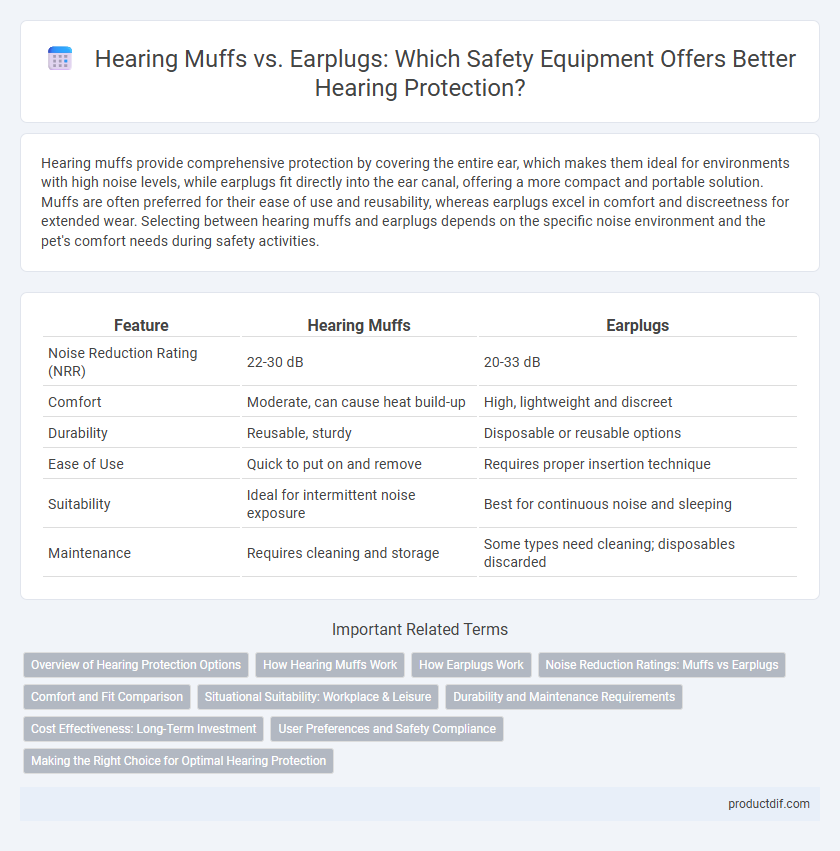Hearing muffs provide comprehensive protection by covering the entire ear, which makes them ideal for environments with high noise levels, while earplugs fit directly into the ear canal, offering a more compact and portable solution. Muffs are often preferred for their ease of use and reusability, whereas earplugs excel in comfort and discreetness for extended wear. Selecting between hearing muffs and earplugs depends on the specific noise environment and the pet's comfort needs during safety activities.
Table of Comparison
| Feature | Hearing Muffs | Earplugs |
|---|---|---|
| Noise Reduction Rating (NRR) | 22-30 dB | 20-33 dB |
| Comfort | Moderate, can cause heat build-up | High, lightweight and discreet |
| Durability | Reusable, sturdy | Disposable or reusable options |
| Ease of Use | Quick to put on and remove | Requires proper insertion technique |
| Suitability | Ideal for intermittent noise exposure | Best for continuous noise and sleeping |
| Maintenance | Requires cleaning and storage | Some types need cleaning; disposables discarded |
Overview of Hearing Protection Options
Hearing muffs provide a robust barrier against high noise levels by fully covering the ears, making them ideal for industrial environments with consistent loud sounds. Earplugs offer versatile protection, fitting inside the ear canal for comfort and convenience, especially suited for intermittent or variable noise situations. Both options effectively reduce noise exposure, but the choice depends on the specific hazard intensity, duration, and user preference.
How Hearing Muffs Work
Hearing muffs work by creating a seal around the ears, using cushioned cups filled with sound-absorbing materials to block out noise effectively. Their design reduces the transmission of sound waves to the eardrum, providing consistent noise attenuation in high-decibel environments such as construction sites or factories. Compared to earplugs, hearing muffs offer easier application and are highly visible for safety compliance monitoring.
How Earplugs Work
Earplugs reduce noise by creating an airtight seal within the ear canal, blocking sound waves from reaching the eardrum. They are typically made from foam, silicone, or wax, molding to the ear's shape to absorb and dampen sound vibrations effectively. Earplugs are lightweight, discreet, and provide consistent noise reduction, making them ideal for environments requiring moderate to high-level hearing protection.
Noise Reduction Ratings: Muffs vs Earplugs
Hearing muffs typically offer Noise Reduction Ratings (NRR) ranging from 20 to 30 decibels, effectively reducing exposure to high-level noise environments. Earplugs generally provide NRRs between 15 and 33 decibels, depending on the material and fit, with custom-molded earplugs often achieving the highest ratings. Choosing between muffs and earplugs depends on factors such as comfort, convenience, and the specific noise reduction requirements of the workplace or activity.
Comfort and Fit Comparison
Hearing muffs offer adjustable headbands and cushioned ear cups that provide consistent pressure distribution, enhancing comfort during prolonged use. Earplugs, made from foam or silicone, conform directly to the ear canal, offering a customizable fit that reduces pressure points and allows for greater mobility. Comfort preferences vary based on individual ear shape and duration of wear, with hearing muffs generally preferred for extended periods and earplugs favored for discreet, low-profile protection.
Situational Suitability: Workplace & Leisure
Hearing muffs provide versatile protection in noisy industrial environments where machinery generates consistent high decibel levels, effectively reducing sound exposure without blocking all ambient noise, which is crucial for situational awareness. Earplugs excel in leisure settings such as concerts or shooting ranges by offering discreet, customizable noise attenuation that preserves sound clarity while minimizing ear canal irritation. Selecting between hearing muffs and earplugs depends on balancing protection needs, comfort, and the necessity for communicating or receiving auditory cues in specific workplace or recreational contexts.
Durability and Maintenance Requirements
Hearing muffs offer greater durability due to their rigid construction and reusable design, making them ideal for long-term use in industrial environments. Earplugs, often made from foam or silicone, require frequent replacement to maintain effectiveness, increasing maintenance efforts. Regular cleaning and inspection are necessary for hearing muffs to ensure optimal performance, while earplugs demand strict hygiene practices to prevent ear infections.
Cost Effectiveness: Long-Term Investment
Hearing muffs generally offer a higher initial cost but provide durable protection and reusable features, making them cost-effective over time for frequent use. Earplugs, while cheaper upfront, often require regular replacement due to wear and hygiene concerns, increasing long-term expenses. Evaluating usage frequency and maintenance needs is crucial for determining the most cost-effective hearing protection investment.
User Preferences and Safety Compliance
Hearing muffs provide comprehensive ear coverage, preferred by users seeking high noise reduction and ease of use without insertion discomfort. Earplugs offer a more discreet fit and portability, favored in environments requiring frequent communication or helmet compatibility. Both meet safety compliance standards, but choice depends on user comfort, noise environment, and specific occupational safety regulations.
Making the Right Choice for Optimal Hearing Protection
Hearing muffs provide comprehensive coverage by enveloping the entire ear, offering high noise reduction ratings (NRR) ideal for extremely loud environments, while earplugs fit directly in the ear canal, delivering a more discreet and portable option with varying levels of protection suited to different noise intensities. The right choice depends on factors such as the noise environment, comfort, duration of use, and compatibility with other safety gear, ensuring maximum effectiveness without compromising usability. Prioritizing devices with certified NRR values and proper fit enhances hearing preservation in industrial, construction, or recreational settings.
Hearing muffs vs Earplugs Infographic

 productdif.com
productdif.com